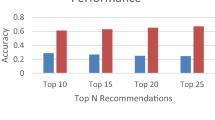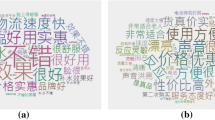Abstract
Reviews, comments and feedbacks are user-generated content which comprises of insights regarding a given item or a thing and furthermore user’ emotions. Various highlights of user-created content incorporate feelings, opinions and survey helpfulness that shows a promising research in the field of recommender systems. Reviews contain various words and sentences that show their natural passionate substance. Emotions are a significant component of human conduct. They enable us for decision making by generating a liking or disliking toward a particular item. This paper harnesses reviews as the content generated from user to exploit, emotion as a basis for generating recommendations. Through experiments conducted on real dataset, our proposed approach compares the performance with traditional item-based collaborative filtering approach. Experimental results show 173% increase in prediction accuracy for top 25 recommendations as compared to prediction accuracy based on rating-based item similarity.
Access this chapter
Tax calculation will be finalised at checkout
Purchases are for personal use only
Similar content being viewed by others
References
Adomavicius G, Tuzhilin A (2005) Toward the next generation of recommender systems: a survey of the state-of-the-art and possible extensions. IEEE Trans Knowl Data Eng 6:734–749
Shi Y, Larson M, Hanjalic A (2010) Mining mood-specific movie similarity with matrix factorization for context-aware recommendation. In: Proceedings of the workshop on context-aware movie recommendation. ACM, pp 34–40
Winoto P, Tang TY (2010) The role of user mood in movie recommendations. Expert Syst Appl
Baldoni M, Baroglio C, Patti V, Rena P (2012) From tags to emotions: ontology-driven sentiment analysis in the social semantic web. Intell Artif 6(1):41–54
Munjal P, Kumar S, Kumar L, Banati A (2017) Opinion dynamics through natural phenomenon of grain growth and population migration. In: Hybrid intelligence for social networks. Springer, Cham, pp 161–175
Munjal P, Narula M, Kumar S, Banati H (2018) Twitter sentiments based suggestive framework to predict trends. J Stat Manag Syst 21(4):685–693
Munjal P, Kumar L, Kumar S, Banati H (2019) Evidence of Ostwald Ripening in opinion driven dynamics of mutually competitive social networks. Phys A 522:182–194
Saraswat M, Chakraverty S, Sharma A (2020) Based topic distribution profile for recommender systems. In: Advances in data sciences, security and applications. Springer, Singapore, pp 433–443
Harper FM, Konstan JA (2016) The movielens datasets: history and context. ACM Trans Interact Intell Syst (Tiis) 5(4):19
Chakraverty S, Saraswat M (2017) Review based emotion profiles for cross domain recommendation. Multim Tools Appl 76(24):25827–25850
Chakraverty S, Sharma S, Bhalla I (2015) Emotion–location mapping and analysis using twitter. J Inf Knowl Manag 14(03):1550022
Karthik K, Ponnusamy R (2011) Adaptive machine learning approach for emotional email classification. In: International conference on human-computer interaction. Springer, Berlin, pp 552–558
Johnson D, Sinanovic S (2001) Symmetrizing the Kullback-Leibler distance. IEEE Trans Inf Theory
Saraswat M, Chakraverty S, Kala A (2020) Analyzing emotion based movie recommender system using fuzzy emotion features. Int J Inf Technol 1–6
Karypis G (2001) Evaluation of item-based top-N recommendation algorithms. In: Proceedings of the tenth international conference on information and knowledge management. ACM, pp 247–254
Author information
Authors and Affiliations
Editor information
Editors and Affiliations
Rights and permissions
Copyright information
© 2021 The Author(s), under exclusive license to Springer Nature Singapore Pte Ltd.
About this paper
Cite this paper
Saraswat, M., Chakraverty, S. (2021). Emotion Distribution Profile for Movies Recommender Systems. In: Sharma, H., Gupta, M.K., Tomar, G.S., Lipo, W. (eds) Communication and Intelligent Systems. Lecture Notes in Networks and Systems, vol 204. Springer, Singapore. https://doi.org/10.1007/978-981-16-1089-9_30
Download citation
DOI: https://doi.org/10.1007/978-981-16-1089-9_30
Published:
Publisher Name: Springer, Singapore
Print ISBN: 978-981-16-1088-2
Online ISBN: 978-981-16-1089-9
eBook Packages: EngineeringEngineering (R0)




